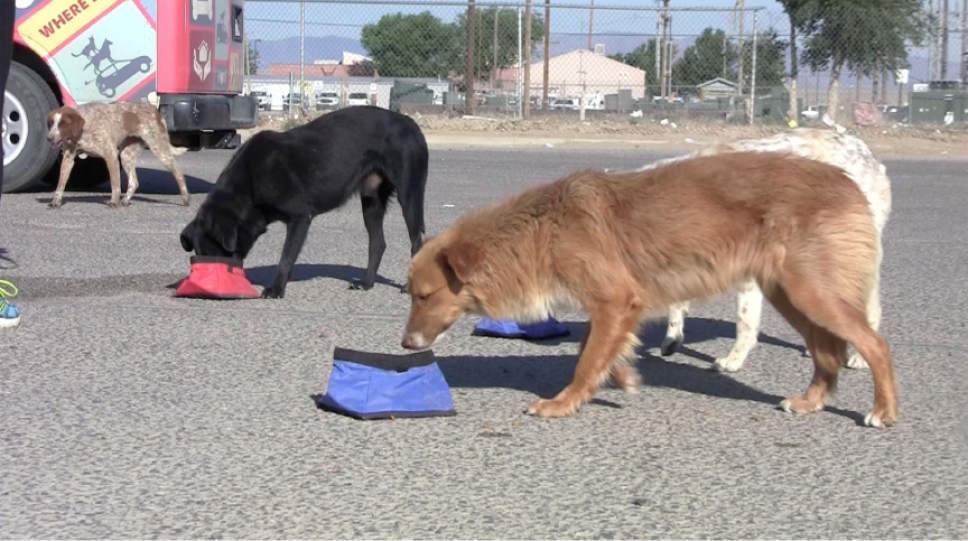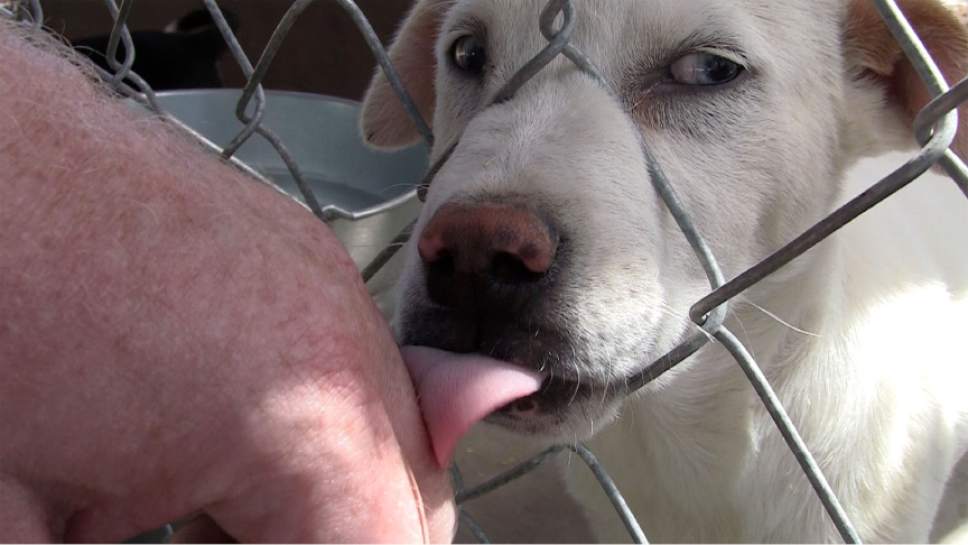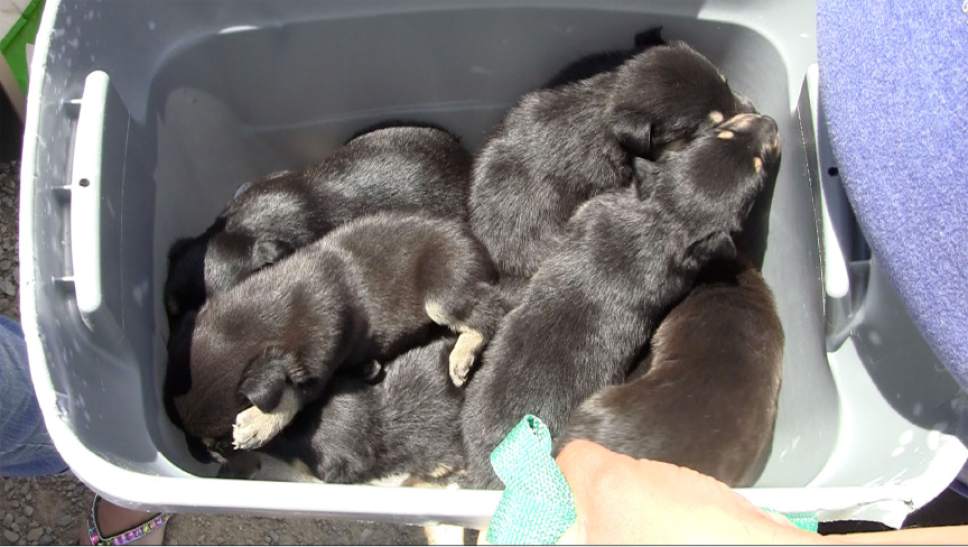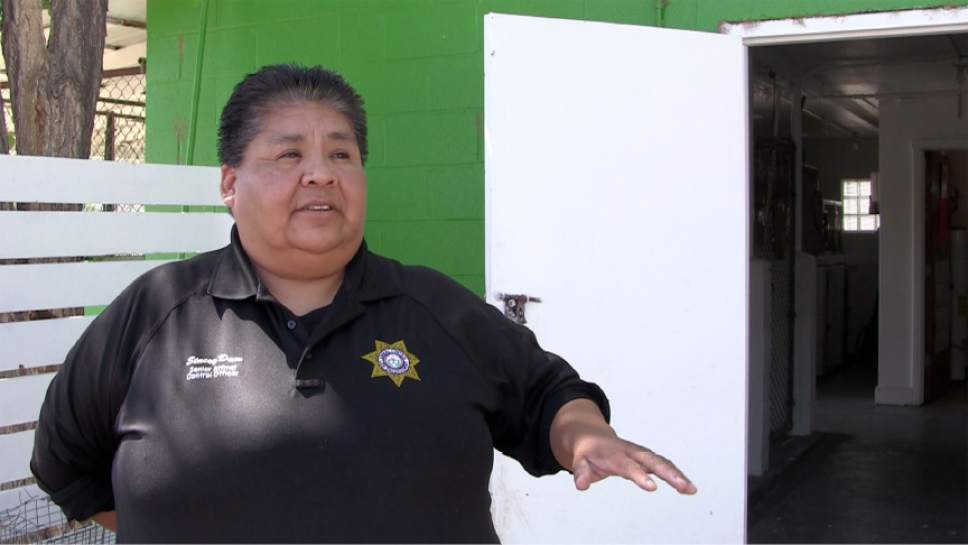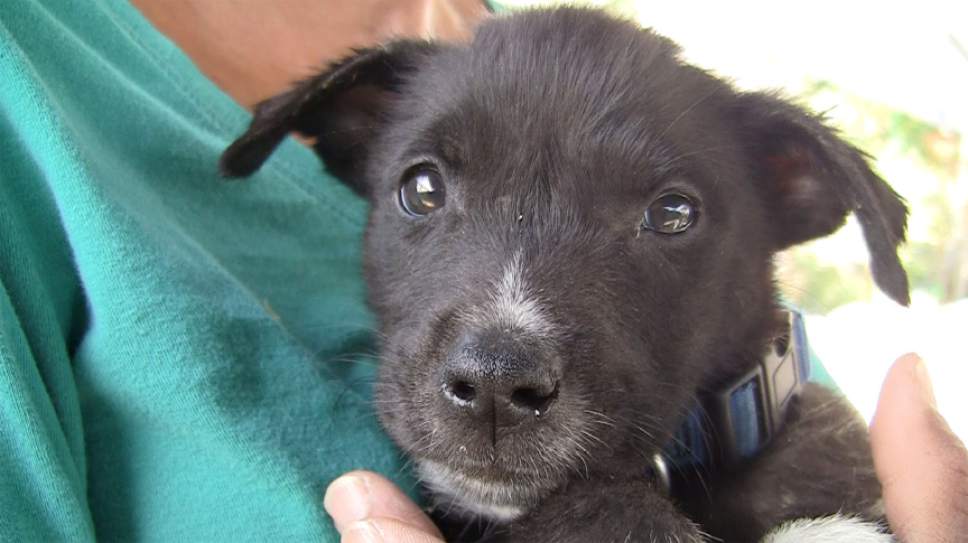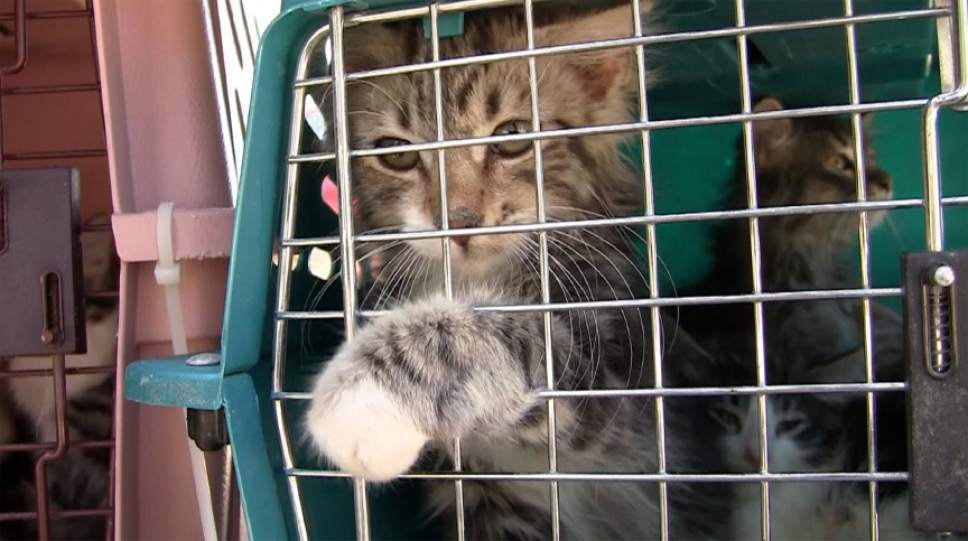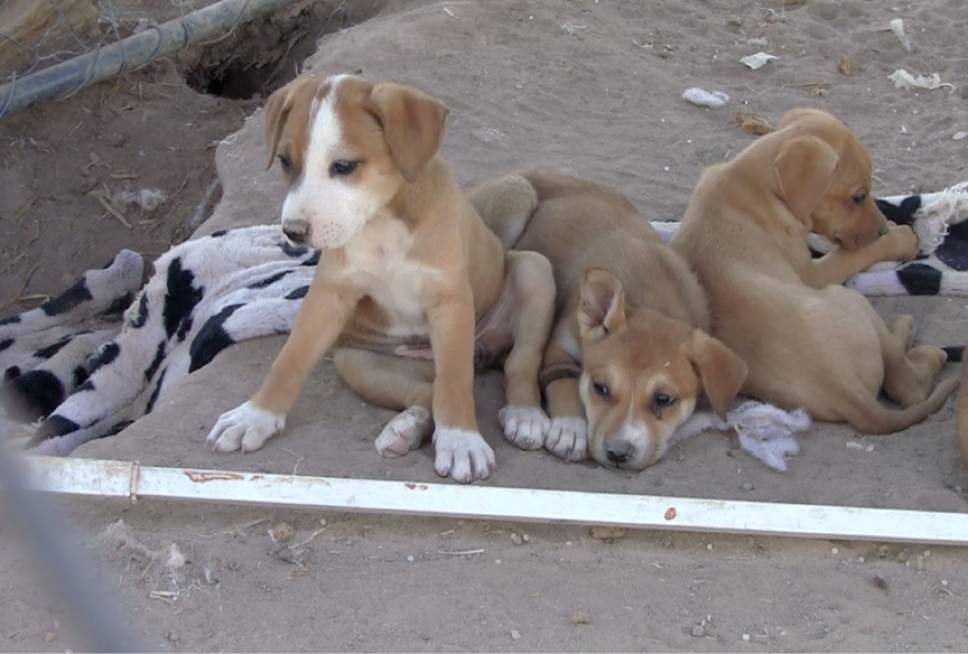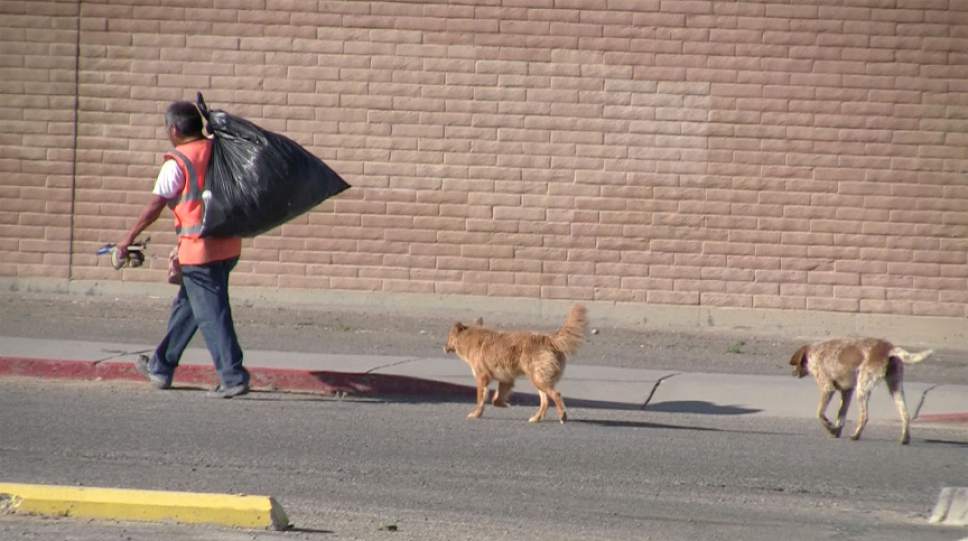This is an archived article that was published on sltrib.com in 2016, and information in the article may be outdated. It is provided only for personal research purposes and may not be reprinted.
Shiprock, N.M. • The dog limps across the busy state highway, barely avoiding a string of speeding cars, rib cage visible through her short brown coat. Her front left paw is mangled, and she drags it along while padding her way toward the roadside brush. From her distended nipples, she clearly has puppies. Is she returning to feed them? Are they even still alive?
Two minutes later, another dog trots across the highway from one gas station convenience store to another — just as scrawny, just as hungry, just as desperate for ... food? Affection? A home?
It's not uncommon to see wandering dogs in various states of neglect when you're driving through Kayenta, Ariz. The town is part of the Navajo Nation, a 27,000-square-mile expanse stretching across Utah, Arizona and New Mexico. Like most reservation cities, it's impoverished, with an unemployment rate as high as 30 percent, and people don't have much money to spend on themselves, much less their pets.
And while there are animal-control officers, there aren't nearly enough. In an area the size of West Virginia, there are five full-time officers patrolling from four shelters, trying their best to manage a stray-animal population that estimates have ranged from 100,000 to as many as 445,000.
One Utah group is trying to help out. Once a month, Park City-based Nuzzles & Co. loads up a van with empty cages, makes the 400-mile drive down to the reservation town of Shiprock, N.M., picks up rescued dogs and puppies — sometimes cats and kittens, too — and transports them back, where they are treated for any diseases, vaccinated and adopted out to permanent homes.
"There are very few private vet clinics on the reservation, and resources are few," Nuzzles President Kathleen Toth explains. "It's costly for owners to have their pets spayed and neutered. That can run as high as $300. And the weather is warmer, so dogs tend to have litters all year long. There are lots of dogs and cats out in the street reproducing, and they struggle to survive. Oftentimes, puppies and cats don't make it."
All reservation shelters are high-kill facilities, with as many as 30 animals put down per week at each — a rate of 98 percent. Though rules are difficult to enforce because of the severe officer shortage, it's illegal for dog owners to let their pets run loose. An owner who allows a female dog in heat to roam wild will be fined $100.
The huge stray population has led, perhaps inevitably, to tragedy. In July, a 3-year-old boy was attacked by a pack of five dogs on the reservation near Dilkon, Ariz. He was the fourth person to be killed by free-roaming dog packs on the reservation since 2010. According to the Navajo Nation Animal Control website, 3,000 people a year are treated for animal attacks and bites on the reservation.
—
Pet peeves • The Nuzzles van makes its way along the streets of Shiprock, past fast-food joints, indie markets, vacant lots and government housing. As it turns down a side street and past the City Market strip mall, we see them — a pack of about four dogs, feeding off a small pile of trash on the outer edge of the mostly empty parking lot.
The van pulls into the lot, and Toth and her Nuzzles crew empty out. They open a couple of bags of kibble, pour fresh water, and then wait.
The dogs see them and carefully inch over, hesitant at getting too close to the strangers. But the prospect of an easy meal wins them over, and soon they're chowing down lunch and lapping up water. Out of seemingly nowhere, other dogs appear and join in the feast, until there are about eight.
Watching this play out is William Shirley, who works for the city picking up trash.
"I see a lot of stray dogs out here," Shirley says. "Dogs will have litters, then the people will leave the litters out here in the parking lot pretty much every day during mating season. The dogs will get into the trash looking for something to eat, looking for scraps. They're sort of left to survive on their own."
These pooches are hungry, but they aren't bone-thin or emaciated like the ones in Kayenta, suggesting that they're getting fed regularly.
It turns out that they likely are owned animals that live in a housing tract across the street. They eat because, well, what dog would refuse a free meal?
"Any supermarket or gas station, any place where there are people, someone will feed these dogs," says Darrell McCurtain, the intake director for Nuzzles, and Navajo himself. "They're just looking for a handout. Some may seem like they're strays, but they probably belong to somebody because a lot of these homes don't have fenced yards; they're not kept in confined spaces like people keep their dogs off the reservation, so they just wander, then they go back home."
Many times those dogs will shuffle onto the roads and get injured or killed by traffic. Additionally, tourists passing through the reservation will take dogs home with them, not realizing that, even without collars or identification tags, the canines may be owned, even though they may not be in the best shape.
Stacy Daw, one of the few animal-control officers who patrol the reservation, says some problems can be based in cultural differences.
"Tourists coming in may not be able to understand that there are people who live their lives in a certain way," Daw says.
"The ones we saw at the market were a little skittish," McCurtain says. "They were unsure of what we were doing, and I think that comes from people mistreating them and shooing them away. That makes me sad. But, at the same time, I think some of these animals are used to this life. They're used to freedom, they're used to wandering, they're used to not being on a chain or leash or in a yard."
And since the dogs have no ID collars, animal-control crews have no way of knowing if they belong to anyone, McCurtain says. "With only four shelters, they can only keep animals until Thursday or Friday, so if they're not reclaimed by their owners or adopted or rescued by groups such as Nuzzles, they're euthanized."
—
Furry lives matter • About an hour later, we're pulling up the long dirt driveway of Izzy Alire and Yvonne Todacheene, a husband-and-wife team that runs the only animal-rescue operation in Shiprock.
We are greeted by the couple's own pack of barking dogs out front. On this hot day, many are lazily resting in various blots of shade.
In the back are kennels where the stray dogs they rescue are kept. Puppies are everywhere doing puppy things such as playfully wrestling and jostling for position when a hose sprays cool water on them.
The couple have some animals they're prepping to give to Nuzzles, and lots of loading and organizing need to be done — ensuring puppies are placed with their mothers, and leaving enough snacks and water for the long trek to Park City.
The two have been doing this for eight years on the front lines of the reservation's stray-dog scourge. In 2015, more than 1,600 animals went through their rescue operation, each pulled from Navajo shelters.
"In a city, you'll see dogs running here and there, but here, it's much more normal," Yvonne Todacheene says while clutching a squirming pup. "There are people in the community that kind of watch them, so you can pick out the regular dogs and which are the new ones that may have gotten dumped."
That happens regularly on the reservation, she says. People will leave litters in public places like the City Market parking lot, because they can't afford to take care of a new batch of puppies, ultimately leaving their fate to the kindness of others.
"People here don't seem to value their dogs," Todacheene says. "They're more like property. The thing that really gets me is, they'll take a puppy and the puppy gets to be 6 months old, then they'll just dispose of the animals. To me, that's not Navajo. That's not traditional. That's not harmony. That's not one with nature."
Sometimes, worse happens.
"They will dispose of them," Todacheene says. "Puppies, too. They'll put them in a bag, tie it closed and throw them in the river. Some shoot the unwanted ones or just dump them anywhere and leave them to fend for themselves.
"Big-time spay-and-neuter needs to happen all over the reservation," Todacheene says. "But people just can't afford that."
Since there are so few animal-control officers, calls have to be prioritized, with livestock attacks taking precedent. A call for a stray or injured dog is not viewed as important, unless biting has occurred.
When that happens, and uncertainty exists about which animal has done the deed, control officers conduct large stray roundups. In these sweeps, many dogs are euthanized, even puppies. In 2011, 11,492 dogs and cats were collected during these crackdowns, and most were put down, according to Navajo Nation data. Rounded-up dogs that are pregnant are routinely euthanized.
"They will pick up all the loose dogs and give the owners three days to reclaim them," says Izzy Alire, who sits beneath a tree in the front of his house, taking a break from loading up the Nuzzles cages. "If they don't reclaim their dog, animal control will call us, then groups like Nuzzles can move them. The shelters don't really have the funding to do anything but euthanize the animals. And some dogs are feral and just not fixable."
Alire says the stray-dog problem, particularly around Kayenta, can affect tourism, which winds up hurting the entire reservation.
"Some tourists will go through Kayenta on the way to Monument Valley. They'll see all the stray dogs, and it will pull on their heartstrings, and they won't come back and won't spend their hard-earned money on the reservation because it hurts their feelings to see how badly some of the animals are treated."
Emotional tourists will also see a cute and hungry stray dog with no collar or ID, and, assuming it doesn't belong to anyone, take it home.
"They wind up dognapping somebody's dog who's just out socializing and enjoying his day," Todacheene says. "They'll think, 'Oh, poor dog,' and grab them. Then, a day or two later, that dog's owner will be looking for their missing pet."
"I've noticed when people start missing their dogs, they come in and we'll ask when was the last time they saw their dog, and they'll say two weeks ago," Daw says.
"A lot of people just assume the dog will come home. But pretty soon, Fido isn't coming home."
—
'Not a job for everybody' • Daw is rumbling along in a pickup truck on the dusty back roads of Shiprock, checking on some recent complaints of stray dogs. Though it's illegal for owned dogs to run loose — the fine is $50 — there aren't enough officers on the reservation to enforce the law.
We pull into a dirt driveway. Daw gets out, walks up to the front door and knocks. Several times. No answer. She writes a note and leaves her business card.
Back in the truck, we take a long drive to another home on the other side of Shiprock, where someone also phoned in a stray-dog sighting. We reach the general area and see no sign of a stray anything. But there is a dog carcass lying by the highway, which looks as if it was just recently hit by a car.
It's a typical day for Daw — a Tuesday, not even 11 a.m. yet, and she's already received 15 calls. The Shiprock office only has a staff of two, so she must prioritize which calls to investigate. Dog-bite cases and livestock attacks always top the list.
"It's a big area for only a few animal-control officers to cover," says Daw, who has worked this beat on the reservation since 1994. "People think, 'Where are they? I called two weeks ago and nobody showed up,' and I have to tell them, 'I'm sorry, but we're doing the best we can.' "
A new shelter in the Crown Point area of the reservation is planned, Daw says, which will add to the four other reservation shelters — in Tuba City, Fort Defiance, Many Farms and Shiprock.
Animal-control services have not always been this scarce.
Back in 1998, Daw says, 16 officers patrolled the reservation — not nearly as many you would find in the Salt Lake City area, but better than today's meager staff.
"It was great," Daw reflects. "Response time on calls was always quick — boom, boom, boom. Each shelter had two vehicles, and one officer would go out on patrol while another stayed at the shelter. But it only lasted two years. Then came budget cuts, and we had to lay them off."
"Now," she adds, "we're back down to five officers, so we're still trying to do what we can with what we have. And the problems don't go away."
There's also high turnover.
"We get people who can't handle this type of work. They can't see a dog being euthanized. Puppies, kittens ... it's too much for them, so they just resign. It's not a job for everybody, and it's hard to find people. We had a budget for an officer in Tuba City, but nobody applied and nobody qualified, so we had to get rid of the position. And that really hurts the community because another officer has to respond to calls in that area, and it can take three or four hours to drive to where the call came from and drive back."
The Shiprock shelter works closely with Yvonne and Izzy. If Daw finds dogs that can be rehabilitated and adopted out, she'll call the couple, and they'll take them in.
The collaboration has boosted the number of reservation dogs picked up by Nuzzles & Co. and other charitable groups in the past six years to around 1,200 annually. Other groups such as Colorado-based Soul Dog Rescue set up free vaccination and spay-and-neuter clinics on the reservation several times a year, helping to decrease deadly dog diseases like parvovirus as well as unwanted litters.
But the biggest dangers to dogs are humans.
"The strays will get hit and killed by cars. Maybe someone just hates dogs and they will try and feed it some poison. Some just can't handle a litter, and they'll leave them beside the road with a sign that says 'Free Puppies,' hoping tourists will take them home. Or they'll abandon them in our parking lot when we're closed."
Many wanted dogs aren't well cared for either, Daw says. "Some dogs are chained up 24/7 outside of these houses, because a lot of houses aren't fenced. They're left in the heat, with little human interaction, and given scraps mixed with dog food. And that's their one meal a day.
"If people are moving to a reservation town from a rural area, they may not know there are animal-control laws. Their pets have never been restrained, never been given a name, never had a collar on them, probably never been vaccinated.
"And they let them roam, and that starts causing problems with the neighbors. We show up and try to educate them, and they'll put a collar on them and tie them up, but you can tell when a dog has never been tied before. It's choking itself on a rope, struggling to get out. That's pretty common all over Navajo Nation."
And yet, with all of the obstacles that Daw and the reservation dogs are up against, some stories make her job worthwhile.
"There was a dog I picked up because it was starving in someone's yard with a collar embedded in its skin around its neck," Daw recalls. "If they're keeping dogs in those conditions, they shouldn't even have a pet. They shouldn't even have a goldfish. So I had to break the chain. I started walking the dog, and it quickly grabbed its own droppings and swallowed them. So I dropped it off at Yvonne and Izzy's, and three weeks later they told me it was recovering. Two months later, Yvonne told me the dog found a new home with a new family, in a big house with a yard and trees. Now he has a new life."
And Daw has one less dog to worry about.


